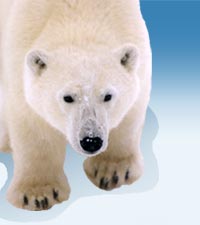
Quick Polar Bear Facts
| Name: | Polar Bear Ursus maritimus=sea bear, nanook (Inuit), Wapusk (Cree), Lords of the Arctic.
Males are Boars and females are Sows. A group of polar bears is called a "Celebration of Polar Bears". |
||
|---|---|---|---|
| Population: | Researchers think there are about 30,000 polar bears in the world.
|
||
| Where do they live? | The polar bear is found in Russia, Norway, Greenland, the United States and Canada.
|
||
| Physical Characteristics | Height: | On all fours - about 1m (3 1/2' at the shoulder). On hind legs - to 3m (10') | |
| Sows are usually smaller than boars. | |||
| Weight: | Adult sows can weigh about 300kg (660lbs). Adult boars are about 550kg (1200 lbs.) | ||
| Age: | Known to live 20-30 years. Few wild polar bears make it past 20 years. | ||
| Oldest captive polar bear: 41 years. Oldest wild polar bear: 32 years. | |||
| Paws: | Up to 30cm (12") across or more. | ||
| Neck & Head: | Their long necks allow the bears to look around and get a good view when swimming. | ||
| Teeth: | 42 sharp teeth, which grow a little each year. | ||
| Tail: | Polar bears have very small tails that are only about 10cm (4") long. | ||
| Abilities | Running: | Up to 40km/h (25 mph) for short distances. | |
| Swimming: | Up to 10km/h (6mph) and for great distances, 96km (60 miles)! | ||
| Diving: | Polar bears can dive about 4.5m (15') underwater. | ||
| Smell: | A bear can detect a seal buried 3' deep in snow 1km away (almost a mile)! | ||
| Sight: | Good eyesight with excellent depth perception. | ||
| Hearing: | They can hear the same range of sounds that people can. | ||
| Staying Warm | Fur: | A polar bear's coat is about 2.5 to 5 cm (1-2") thick. | |
| Close to their body polar bears have a thick layer of woolly fur to keep them warm. | |||
| Fat: | A thick layer of fatty-blubber helps insulate the bear and keep him/her warm. | ||
| Skin: | The skin is black under all that white fur. | ||
| Food & Hunting | Food: | Seals, Beluga Whales, Walruses and sometimes a bit of seaweed. Not Fish! | |
| Hunting: | When a seal comes to the surface, the bear uses its claws and teeth to catch it. | ||
All photos and images are for use at the author's discretion.
Please gain permission before using.
Copyright © 2000-2004 mikepolarbear@yahoo.ca
Please gain permission before using.
Copyright © 2000-2004 mikepolarbear@yahoo.ca

